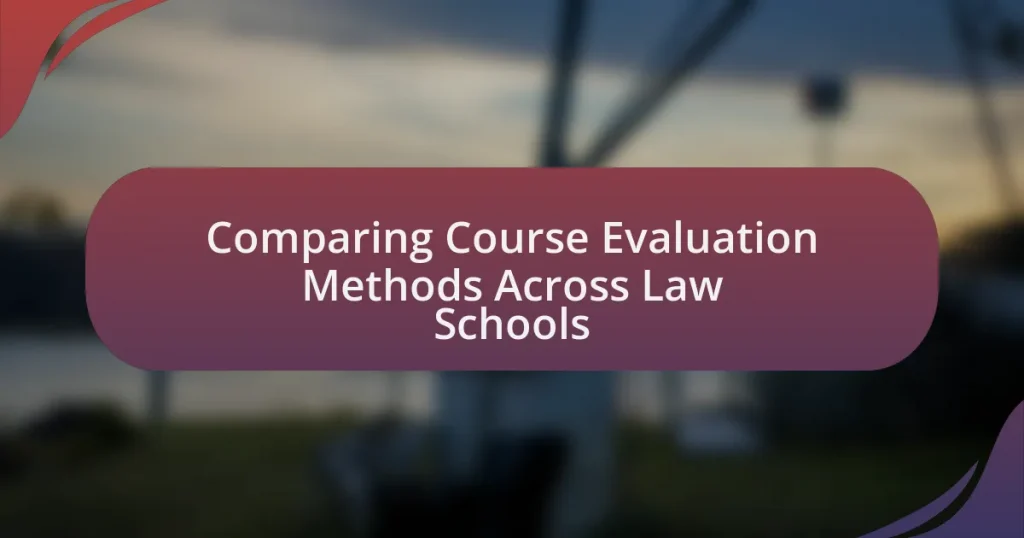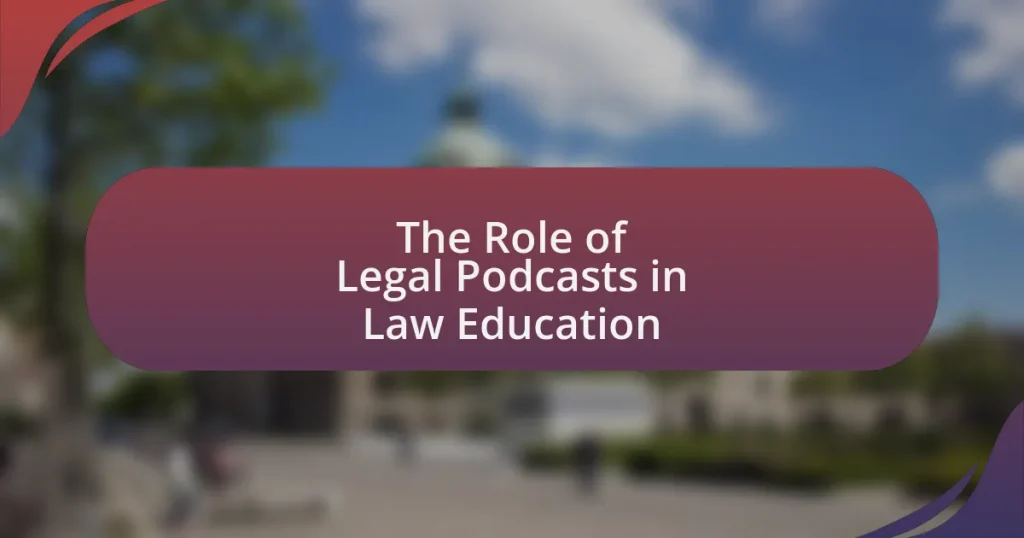The article examines various course evaluation methods utilized in law schools, including student evaluations, peer assessments, self-assessments, and standardized assessments. It contrasts traditional evaluation methods, which often rely on standardized testing and subjective assessments, with modern approaches that incorporate continuous feedback and technology-enhanced evaluations. The discussion highlights the importance of course evaluations in maintaining educational quality, the challenges faced by law schools, and the impact of biases on evaluation results. Additionally, it explores strategies for improving evaluation processes, including the use of data analytics and online platforms, to enhance the reliability and effectiveness of feedback mechanisms in legal education.
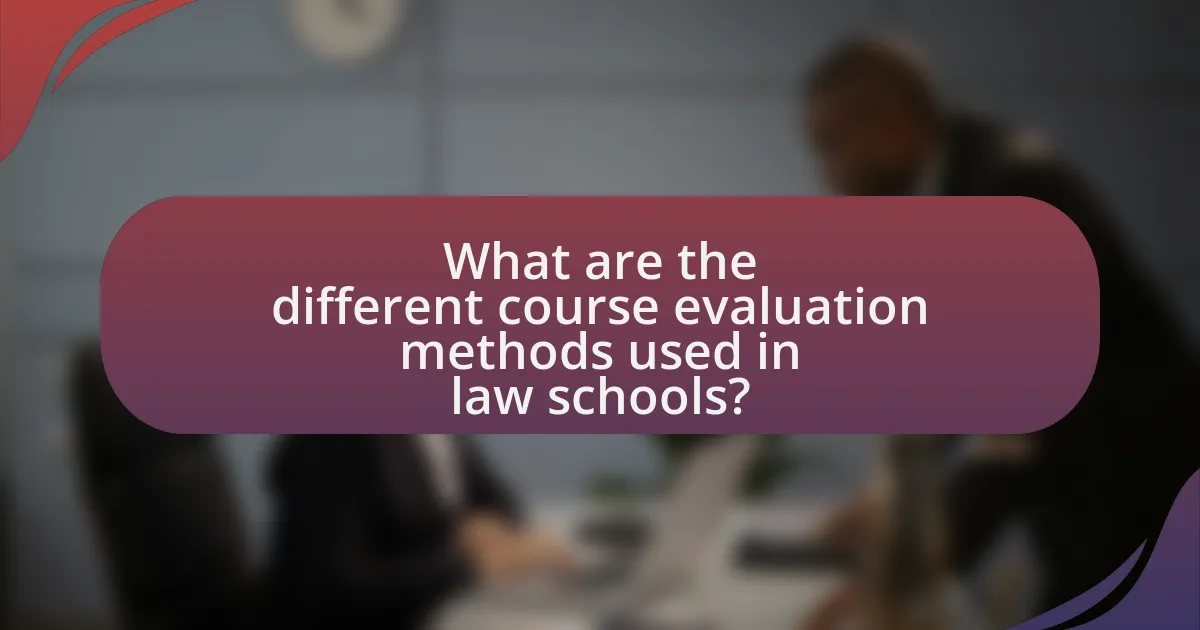
What are the different course evaluation methods used in law schools?
Law schools utilize various course evaluation methods, including student evaluations, peer evaluations, self-assessments, and standardized assessments. Student evaluations typically involve anonymous surveys where students rate instructors and course content, providing quantitative and qualitative feedback. Peer evaluations involve faculty members assessing each other’s teaching effectiveness, often focusing on pedagogical techniques and course delivery. Self-assessments require instructors to reflect on their teaching practices and student outcomes, promoting professional development. Standardized assessments, such as bar exam performance and other metrics, offer objective measures of educational effectiveness. These methods collectively contribute to a comprehensive understanding of teaching quality and student learning in law schools.
How do traditional evaluation methods compare to modern approaches?
Traditional evaluation methods primarily rely on standardized testing and subjective assessments, while modern approaches incorporate continuous feedback, peer evaluations, and technology-enhanced assessments. Traditional methods often emphasize summative evaluations, which can limit the scope of student performance measurement, whereas modern approaches focus on formative assessments that provide ongoing insights into student learning and engagement. Research indicates that modern evaluation methods can lead to improved student outcomes, as they foster a more comprehensive understanding of student capabilities and learning processes, thus enhancing educational effectiveness.
What are the key features of traditional evaluation methods?
Traditional evaluation methods primarily feature standardized testing, instructor assessments, and summative evaluations. Standardized testing provides a uniform measure of student performance, allowing for comparison across different cohorts. Instructor assessments involve subjective evaluations based on classroom participation, assignments, and overall engagement, which can reflect a student’s understanding and application of course material. Summative evaluations, often conducted at the end of a course, assess cumulative knowledge and skills acquired, providing a comprehensive overview of student learning outcomes. These methods have been widely used in educational settings, particularly in law schools, to ensure consistency and reliability in measuring student performance.
What innovations characterize modern evaluation methods?
Modern evaluation methods are characterized by the integration of technology, real-time feedback mechanisms, and data analytics. These innovations enhance the assessment process by allowing for more immediate and actionable insights into student performance and course effectiveness. For instance, the use of online platforms enables instructors to gather feedback through surveys and polls during or immediately after classes, facilitating timely adjustments to teaching strategies. Additionally, data analytics tools can analyze student performance trends over time, providing educators with a comprehensive view of learning outcomes and areas needing improvement. This shift towards a more data-driven approach reflects a broader trend in education to leverage technology for enhanced learning experiences.
Why is it important to evaluate courses in law schools?
Evaluating courses in law schools is crucial for ensuring educational quality and relevance. Regular assessments provide insights into course effectiveness, helping to identify strengths and weaknesses in the curriculum. This process allows law schools to adapt their programs to meet the evolving demands of the legal profession, ensuring that graduates are well-prepared for their careers. Research indicates that institutions that implement systematic course evaluations tend to have higher student satisfaction and better employment outcomes for graduates, reinforcing the importance of this practice in maintaining academic standards and enhancing the overall educational experience.
What impact does course evaluation have on student learning?
Course evaluation significantly impacts student learning by providing feedback that informs instructional practices and enhances course design. Research indicates that when students participate in evaluations, their feedback can lead to improvements in teaching methods, curriculum adjustments, and overall educational quality. For instance, a study published in the Journal of Educational Psychology found that courses with higher evaluation scores often correlate with improved student engagement and academic performance, demonstrating that effective evaluations can foster a more conducive learning environment.
How do evaluations influence faculty performance and curriculum development?
Evaluations significantly influence faculty performance and curriculum development by providing structured feedback that identifies strengths and areas for improvement. Faculty performance is often assessed through student evaluations, peer reviews, and self-assessments, which collectively inform teaching effectiveness and engagement strategies. For instance, a study published in the Journal of Higher Education found that faculty who received constructive feedback from evaluations were more likely to adopt innovative teaching methods and enhance their course materials. Additionally, curriculum development is shaped by evaluation outcomes, as institutions analyze student feedback to align course offerings with learner needs and industry standards. This iterative process ensures that curricula remain relevant and effective, ultimately improving educational quality.
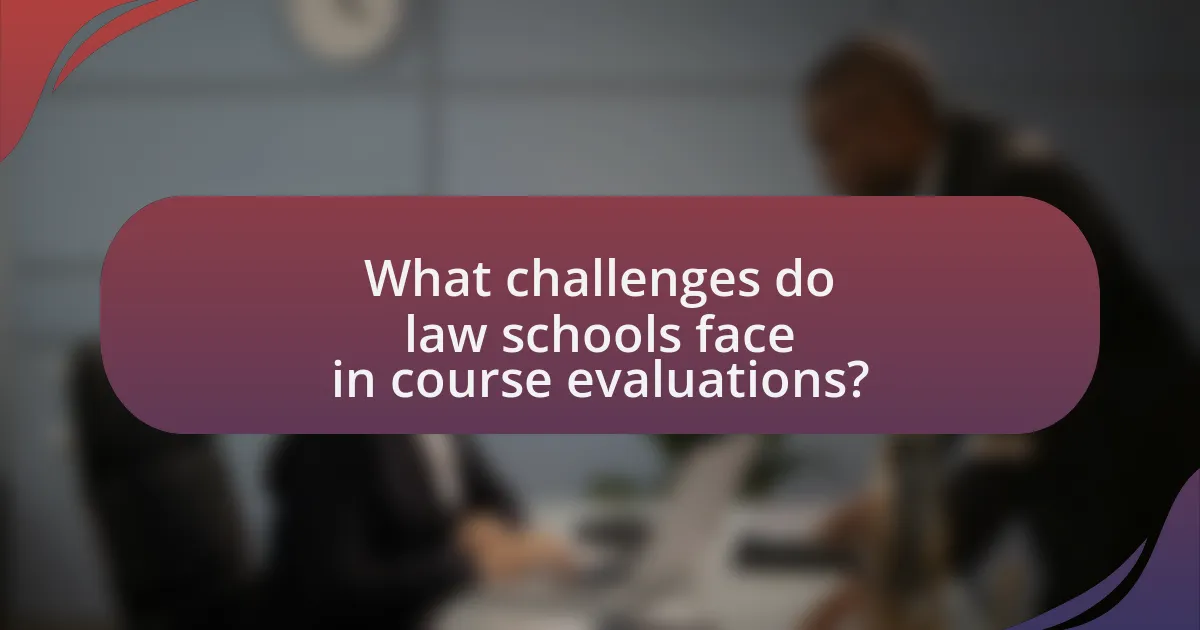
What challenges do law schools face in course evaluations?
Law schools face several challenges in course evaluations, primarily related to bias, low response rates, and the validity of feedback. Bias can stem from students’ perceptions of instructors, which may not accurately reflect teaching effectiveness. Research indicates that evaluations can be influenced by factors such as gender and race, leading to skewed results. Low response rates further complicate the evaluation process, as a small sample may not represent the entire class’s views, diminishing the reliability of the feedback. Additionally, the validity of the evaluations is often questioned, as they may not effectively measure learning outcomes or course content comprehension. These challenges highlight the need for law schools to develop more robust evaluation methods that address these issues.
How do biases affect course evaluation results?
Biases significantly distort course evaluation results by influencing student perceptions and feedback. For instance, gender bias can lead to harsher evaluations for female instructors compared to their male counterparts, as evidenced by research from Boring, Ottoboni, and Stark (2016), which found that female professors received lower ratings despite similar teaching effectiveness. Additionally, confirmation bias may cause students to focus on negative aspects of a course that align with their preconceived notions, further skewing evaluation outcomes. Such biases compromise the reliability of evaluations, making it challenging to accurately assess teaching quality and course effectiveness across law schools.
What types of biases are commonly observed in evaluations?
Commonly observed biases in evaluations include confirmation bias, leniency bias, and halo effect. Confirmation bias occurs when evaluators favor information that confirms their pre-existing beliefs about a course or instructor, leading to skewed assessments. Leniency bias refers to the tendency of evaluators to rate performance more favorably than warranted, which can distort the true quality of the course. The halo effect happens when an evaluator’s overall impression of an instructor influences their ratings on specific criteria, often resulting in inflated scores based on unrelated positive attributes. These biases can significantly impact the reliability and validity of course evaluations in law schools.
How can law schools mitigate these biases?
Law schools can mitigate biases by implementing standardized evaluation criteria and training evaluators on implicit bias awareness. Standardized criteria ensure that all students are assessed based on the same metrics, reducing subjective interpretations that can lead to bias. Training evaluators on implicit bias helps them recognize and counteract their own biases during the evaluation process. Research indicates that structured evaluations can lead to fairer outcomes, as evidenced by a study published in the Journal of Legal Education, which found that law schools employing standardized evaluations reported a decrease in bias-related discrepancies in student assessments.
What are the limitations of current evaluation methods?
Current evaluation methods in law schools face several limitations, including a lack of standardization, potential bias, and limited feedback scope. The absence of uniform criteria across institutions can lead to inconsistencies in how courses are assessed, making it difficult to compare results effectively. Additionally, evaluations often reflect subjective opinions, which can introduce bias based on personal experiences rather than objective measures of course effectiveness. Furthermore, many evaluation methods focus primarily on student satisfaction rather than on learning outcomes, limiting the feedback to superficial aspects of the educational experience. These limitations hinder the ability to accurately gauge the quality of legal education and to implement meaningful improvements.
How do limitations affect the reliability of evaluation outcomes?
Limitations significantly undermine the reliability of evaluation outcomes by introducing biases and inaccuracies in the assessment process. For instance, if a course evaluation method lacks a comprehensive framework, it may fail to capture essential aspects of student learning, leading to skewed results. Research indicates that evaluations with limited response options can restrict feedback, resulting in a narrow understanding of course effectiveness (Berk, 2018). Furthermore, limitations such as small sample sizes or non-representative demographics can distort the findings, making them less generalizable across diverse law school populations. Thus, the presence of these limitations directly correlates with diminished reliability in evaluation outcomes.
What alternative methods could address these limitations?
Alternative methods to address the limitations of current course evaluation methods across law schools include implementing peer evaluations, utilizing formative assessments, and incorporating student self-assessments. Peer evaluations allow students to provide feedback on each other’s performance, fostering a collaborative learning environment and offering diverse perspectives on teaching effectiveness. Formative assessments, such as quizzes and reflective journals, provide ongoing feedback throughout the course, enabling instructors to adjust their teaching strategies in real-time based on student understanding. Student self-assessments encourage learners to reflect on their own progress and learning experiences, promoting accountability and self-directed learning. These methods can enhance the evaluation process by providing a more comprehensive view of teaching effectiveness and student engagement.
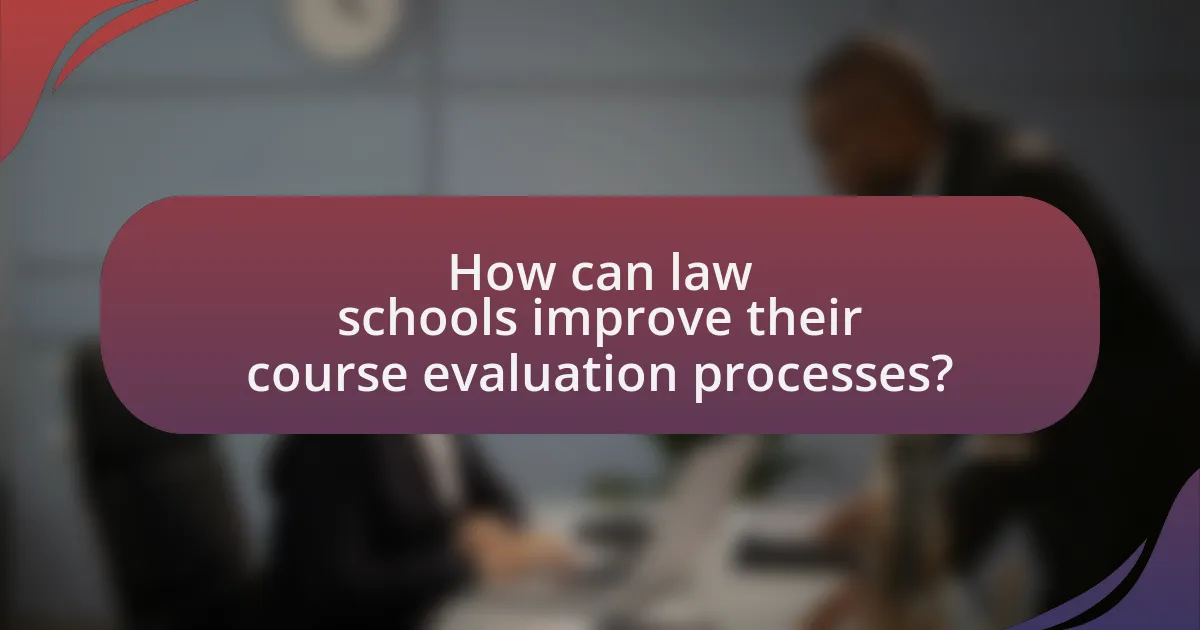
How can law schools improve their course evaluation processes?
Law schools can improve their course evaluation processes by implementing a combination of quantitative and qualitative feedback mechanisms. This dual approach allows for a more comprehensive understanding of student experiences and instructional effectiveness. For instance, incorporating standardized rating scales alongside open-ended questions can yield both measurable data and rich, descriptive insights. Research indicates that institutions employing mixed-method evaluations often report higher student satisfaction and more actionable feedback, as seen in studies conducted by the Association of American Law Schools, which highlight the benefits of diverse evaluation formats in enhancing educational quality.
What best practices should law schools adopt for effective evaluations?
Law schools should adopt a combination of quantitative and qualitative evaluation methods to ensure effective assessments. Quantitative methods, such as standardized surveys with Likert scales, provide measurable data on student satisfaction and learning outcomes, while qualitative methods, like open-ended feedback, offer deeper insights into student experiences and instructional effectiveness. Research indicates that using both approaches leads to more comprehensive evaluations, as evidenced by a study published in the Journal of Legal Education, which found that schools employing mixed methods reported higher levels of student engagement and satisfaction. Additionally, regular training for faculty on evaluation interpretation and feedback incorporation enhances the effectiveness of the evaluation process, fostering continuous improvement in teaching practices.
How can law schools ensure student participation in evaluations?
Law schools can ensure student participation in evaluations by implementing anonymous feedback mechanisms and integrating evaluations into the course structure. Anonymous feedback encourages honest responses, as students feel secure in sharing their opinions without fear of repercussions. Additionally, making evaluations a part of the course requirements, such as tying them to grades or participation points, can motivate students to engage in the process. Research indicates that when evaluations are perceived as valuable and relevant to the learning experience, participation rates increase significantly. For instance, a study published in the Journal of Legal Education found that law schools that actively communicated the importance of evaluations and provided timely feedback to students saw a 30% increase in participation rates.
What role does feedback play in refining evaluation methods?
Feedback is essential in refining evaluation methods as it provides insights into their effectiveness and areas for improvement. By collecting and analyzing feedback from students and faculty, law schools can identify specific strengths and weaknesses in their evaluation processes. For instance, studies have shown that incorporating student feedback leads to more relevant and tailored evaluation criteria, enhancing the overall educational experience. This iterative process of feedback and adjustment ensures that evaluation methods remain aligned with educational goals and student needs, ultimately leading to more accurate assessments of course effectiveness.
What tools and technologies can enhance course evaluations?
Digital survey platforms, such as Qualtrics and SurveyMonkey, can enhance course evaluations by providing customizable templates and real-time analytics. These tools allow educators to design tailored surveys that capture specific feedback on course content, teaching effectiveness, and student engagement. Additionally, learning management systems (LMS) like Canvas and Blackboard integrate evaluation features that streamline the feedback process, making it easier for students to participate. Research indicates that using technology in course evaluations increases response rates and improves the quality of feedback, as evidenced by a study published in the Journal of Educational Psychology, which found that online evaluations yielded a 20% higher response rate compared to paper-based methods.
How can data analytics improve the evaluation process?
Data analytics can significantly enhance the evaluation process by providing actionable insights derived from large datasets. By analyzing student feedback, performance metrics, and demographic information, educational institutions can identify trends and patterns that inform curriculum improvements and teaching effectiveness. For instance, a study published in the Journal of Educational Psychology found that data-driven evaluations led to a 15% increase in student satisfaction when institutions tailored courses based on analytics insights. This demonstrates that leveraging data analytics not only streamlines the evaluation process but also fosters a more responsive educational environment.
What are the benefits of using online evaluation platforms?
Online evaluation platforms enhance the course evaluation process by providing efficiency, accessibility, and data analysis capabilities. These platforms streamline the collection of feedback, allowing students to complete evaluations at their convenience, which can lead to higher response rates. Research indicates that online evaluations can increase participation by up to 30% compared to traditional paper methods. Additionally, online platforms facilitate immediate data aggregation and analysis, enabling law schools to quickly identify trends and areas for improvement in their courses. This real-time feedback loop supports continuous enhancement of educational quality, making online evaluation platforms a valuable tool in academic settings.
What practical tips can law schools implement for better course evaluations?
Law schools can implement anonymous feedback mechanisms to enhance course evaluations. This approach encourages students to provide honest and constructive criticism without fear of repercussions. Additionally, law schools should utilize mid-semester evaluations to gather timely feedback, allowing instructors to make adjustments while the course is still in progress. Research indicates that courses with mid-semester evaluations often see improved student satisfaction and learning outcomes. Furthermore, law schools can train faculty on how to interpret evaluation data effectively, ensuring that feedback leads to actionable changes. Implementing these strategies can lead to more meaningful course evaluations and ultimately improve the educational experience.
